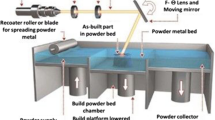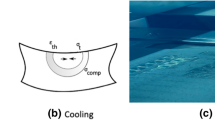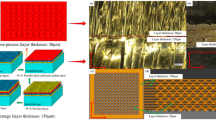Abstract
Laser peen forming (LPF) is promising to form large-scale metal sheets in various applications. Understanding the bending deformation of the LPF process is of particular importance for accurate shape prediction and process planning elaboration. This study established a simplified eigenstrain-based finite element (FEM) model by incorporating loading sequence and geometric non-linearity to explore the bending deformation and shape prediction of the LPF process. The simplified eigenstrain was inversely determined based on the arc heights of plates subjected to full-covered LPF. The above model incorporating loading sequence and geometric non-linearity was verified by the comparison of experimental results, and it improved shape prediction accuracy considerably compared to the common beam bending analytical model. Moreover, the bending deformation processes and mechanisms of LPF plates were elucidated. It was found that biaxially curved surfaces were formed for thick plates with 5 mm or larger thickness, in which the geometric non-linearity and flattening effects played significant roles on their formation. On the other side, monoaxially curved surfaces were obtained for thin plates with 4 mm or smaller thickness after the LPF process. Three stages, i.e., forward bending, reverse flattening, and buckling, occurred and contributed to the formation of the monoaxially curved surface. With the increase in the eigenstrain amplitude and side length, and the decrease in plate thickness, the LPF plates transit from a biaxially curved shape to a monoaxially curved one.

















Similar content being viewed by others
Data availability
Not applicable.
Code availability
Not applicable.
References
Geng Y, Cao X, Zheng H, Li G, Xiao Y (2023) Effect of laser shock peening on the tensile behavior and notch sensitivity of Ni-based single-crystal superalloy. Int J Adv Manuf Technol 125:3267–3276
Zheng C, Pan C, Tian Z, Zhao X, Zhao G, Ji Z, Song L (2020) Laser shock induced incremental forming of pure copper foil and its deformation behavior. Optics Laser Tech 121:105785
Lu HF, Xue KN, Xu X, Luo KY, Xing F, Yao JH, Lu JZ (2021) Effects of laser shock peening on microstructural evolution and wear property of laser hybrid remanufactured Ni25. J Mater Process Technol 291:117016
Schwab K, Keller S, Kashaev N, Klusemann B (2021) Tailoring of residual stresses by specific use of defined prestress during laser shock peening. J Mater Process Technol 295:117154
Li J, Zhou J, Feng A, Huang S, Meng X, Sun Y, Sun Y, Tian X, Huang Y (2018) Investigation on mechanical properties and microstructural evolution of TC6 titanium alloy subjected to laser peening at cryogenic temperature. Mat Sci Eng A 734:291–298
Jiang Q, Li S, Zhou C, Zhang B, Zhang Y (2021) Effects of laser shock peening on the ultra-high cycle fatigue performance of additively manufactured Ti6Al4V alloy. Optics Laser Tech 144:107391
Hackel L, Harris F (2002) Contour forming of metals by laser peening. EP
Hu Y, Xu X, Yao Z, Hu J (2010) Laser peen forming induced two way bending of thin sheet metals and its mechanisms. J Appl Phys 108:73117
Sagisaka Y, Yamashita K, Yanagihara W, Ueta H (2015) Microparts processing using laser cutting and ultra-short-pulse laser peen forming. J Mater Process Technol 219:230–236
Sagisaka Y, Kamiya M, Matsuda M, Ohta Y (2010) Thin-sheet-metal bending by laser peen forming with femtosecond laser. J Mater Process Technol 210:2304–2309
Hu Y, Li Z, Yu X, Yao Z (2015) Effect of elastic prestress on the laser peen forming of aluminum alloy 2024-T351: experiments and eigenstrain-based modeling. J Mater Process Technol 221:214–224
Hu Y, Luo M, Yao Z (2016) Increasing the capability of laser peen forming to bend titanium alloy sheets with laser-assisted local heating. Mater Design 90:364–372
Sala ST, Keller S, Chupakhin S, Pöltl D, Klusemann B, Kashaev N (2022) Effect of laser peen forming process parameters on bending and surface quality of Ti-6Al-4V sheets. J Mater Process Technol 305:117578
Braisted W, Brockman R (1999) Finite element simulation of laser shock peening. Int J Fatigue 21:719–724
Vasu A, Hu Y, Grandhi RV (2013) Differences in plasticity due to curvature in laser peened components. Surf Coat Technol 235:648–656
Engebretsen C, Palazotto A, Langer K (2019) Integrated finite element & optimization model for laser shock pressure impulse shape determination. Eng Res Express 1:15020
Li W, Chen H, Huang W, Chen J, Zuo L, Li C, He J, Ren Y, Zhang S (2021) Effect of laser shock peening on high cycle fatigue properties of aluminized AISI 321 stainless steel. Int J Fatigue 147:106180
Zhang X, Niu W, Zhang Y, Hu X, Fang J, Zuo L, Yin Y, Shah SSA (2021) Investigation of large area sheet forming with laser shocking spot by spot. Mater Design 212:110279
Korsunsky AM (2006) Residual elastic strain due to laser shock peening: modelling by eigenstrain distribution. J Strain Analysis Eng Design 41:195–204
Hu Y, Grandhi RV (2012) Efficient numerical prediction of residual stress and deformation for large-scale laser shock processing using the eigenstrain methodology. Surf Coat Technol 206:3374–3385
Luo M, Hu Y, Hu L, Yao Z (2020) Efficient process planning of laser peen forming for complex shaping with distributed eigen-moment. J Mater Process Technol 279:116588
Faucheux PA, Gosselin FP, Lévesque M (2018) Simulating shot peen forming with eigenstrains. J Mater Process Technol 254:135–144
Murakawa H, Okumoto Y, Rashed S, Sano M (2013) A practical method for prediction of distortion produced on large thin plate structures during welding assembly. Weld World 57:793–802
Hu Y, Xie Y, Wu D, Yao Z (2019) Quantitative evaluation of specimen geometry effect on bending deformation of laser peen forming. Int J Mech Sci 150:404–410
Korsunsky AM (2005) The modelling of residual stresses due to surface peening using eigenstrain distributions. J Strain Analysis Eng Design 40:817–824
Mylavarapu P, Bhat C, Perla MKR, Banerjee K, Gopinath K, Jayakumar T (2021) Identification of critical material thickness for eliminating back reflected shockwaves in laser shock peening – a numerical study. Optics Laser Tech 142:107217
Hu Y, Yao Z (2008) Numerical simulation and experimentation of overlapping laser shock processing with symmetry cell. Int J Mach Tool Manu 48:152–162
Yang R, Hu Y (2023) Plastic deformation mechanisms and their threshold pressures of Ti6Al4V thin-walled structures induced by laser peen forming. Opt Laser Technol 167:109722
Brazier LG (1927) On the flexure of thin cylindrical shells and other “thin” sections. Proc R Soc Lond Ser A-Contain Pap Math Phys Character 116:104–114
Xu Z, Gardner L, Sadowski AJ (2017) Nonlinear stability of elastic elliptical cylindrical shells under uniform bending. Int J Mech Sci 128-129:593–606
Coman CD (2017) Bifurcation instabilities in finite bending of circular cylindrical shells. Int J Eng Sci 119:249–264
Funding
This study was financially supported under the Grants of Basic Research Projects of Shenzhen Research & Development Fund (No. JCYJ20200109112808109), National Natural Science Foundation of China (No. 52275415), Innovation Project of University of Guangdong Province (No. 2022KTSCX211, No. 2023KTSCX227), and Shenzhen Stable Support Program of University (GXWD20231130002845001).
Author information
Authors and Affiliations
Contributions
Yongheng Liu: investigation, writing of draft
Daxiang Deng: conceptualization, supervision, project administration, funding acquisition, modification of writing
Junxin Liu: investigation
Xin Gu: methodology
Xiuyu Chen: methodology
Corresponding author
Ethics declarations
Ethical approval
Not applicable.
Consent to participate
Not applicable.
Consent for publication
Not applicable.
Conflict of interest
The authors declare no competing interests.
Additional information
Publisher’s Note
Springer Nature remains neutral with regard to jurisdictional claims in published maps and institutional affiliations.
Rights and permissions
Springer Nature or its licensor (e.g. a society or other partner) holds exclusive rights to this article under a publishing agreement with the author(s) or other rightsholder(s); author self-archiving of the accepted manuscript version of this article is solely governed by the terms of such publishing agreement and applicable law.
About this article
Cite this article
Liu, Y., Deng, D., Liu, J. et al. Investigation on the bending deformation of laser peen forming with a simplified eigenstrain-based finite element model. Int J Adv Manuf Technol 131, 5815–5830 (2024). https://doi.org/10.1007/s00170-024-13302-7
Received:
Accepted:
Published:
Issue Date:
DOI: https://doi.org/10.1007/s00170-024-13302-7




